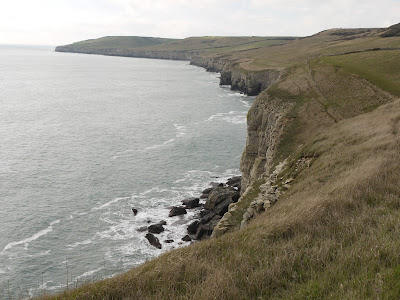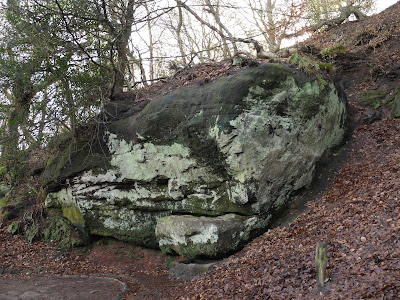The High St
We decided to visit Dorchester and researched some walks around the town from the Visit Dorset website. In the end we collected a leaflet from the Information Centre and did a sort of hybrid of the four possibilities. The online version has better directions, but the leaflet version has a much better map.
We started at the top of South Street at the so-called Town Pump - "a banded obelisk with a ball finial" (Pevsner). We turned left along the West High St. At the end, we briefly turned left to see the sad, token remains of the old Roman walls. The walls were removed in the late 18th century, but a series of pedestrian tree lined"walks" remain along the lines they formerly followed. This is West Walks.
We returned to the cross roads at the end of West High St to see the inevitable statue of Thomas Hardy. Judging from photos of the great man, it seems to be a very good likeness.
We then continued along Colliton Walk, effectively the northern extension of West Walks.
You pass the unappealing 1930s-1950s County Hall and at the end you turn right to soon find the Roman Townhouse. This was discovered in 1937 as a result of excavations for the new County Hall. The informative information panels explain that it was originally three separate dwellings. The parts that are under cover have interesting fragments of mosaics.
A little further on you drop down to see the unusual curved Hangman's Cottage, which was apparently the home of the town's executioner.
Now you walk along by the fast, shallow, clear River Frome, turn right up Friary Hill, past the prison (where I believe one of my uncles worked in the 1950s or 1960s) to return to the High Street via the quiet Grey School Passage.
Turning right into the West High St we passed in quick succession the Dorset Museum (1883), the 15th century St Peter's church and the Shire Hall.
This handsome building dates from 1795-7. Echoing our walk the other day around Tolpuddle, the Tolpuddle Martyrs were tried here in 1834. The courtroom has been preserved in its original state by the TUC.
We now headed back down South Street and turned left into Durngate Street, which follows the line of the main Roman road through Durnovaria (Roman Dorchester). At the end we turned right into a path beside Salisbury Fields, marking the eastern line of the Roman walls. At the end we made a small detour to see St George's church on Fordington Green.
It makes a pretty village scene. The church is Norman in origin, but Pevsner explains that it was more than doubled in size in 1906-27. The result seems out of proportion, both with itself and with its surroundings.
The three figures comprising Elisabeth Frink's 'Dorset Martyrs Statue' (1986) form a striking and memorable composition at the corner of Icen Way and South Walk.
We now walked along South Walks a wide chestnut-lined promenade, which the leaflet thinks is "arguably the most attractive in Dorchester". Then right into Acland Road past a large car park which we were staggered to learn covers the Roman Baths, which were excavated in 1978 and then covered over again. "It is hoped that one day they will be re-opened to the public" (!).
From here, we went through the Tudor Arcade (a modern shopping precinct with a Tudor archway tucked away in a corner) to return to South St and now head south back to where we had parked.
Soon on the left is the delightful Napper's Mite, built as almshouses for ten poor men under the will of Sir Robert Napper in 1616. The beautiful arcaded street front is of 1816.
Further on down the we came to the site of the former Eldridge and Pope brewery, now being redeveloped as upmarket apartments. It dates from 1880 and Pevsner decries the "clashing contrasts of red and cream bricks, machicolation and little windows with huge fanning voussoirs". This block is more restrained, but as fans of Victorian brickwork we thought the whole thing was impressive.
Conditions: dry, a bit chilly.
Distance: about 3 miles in all.
Rating: three and a half stars. Interesting and worthwhile, but a little underwhelming. It seems as though Dorchester has missed opportunities to make the most of its cultural heritage and is now frantically trying to make amends.













































